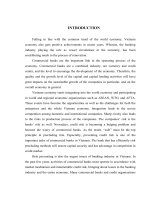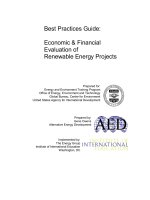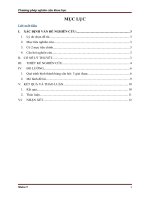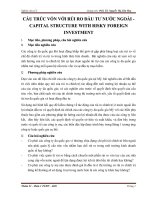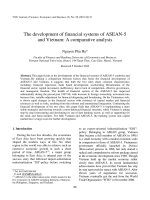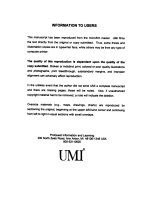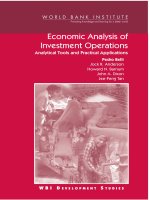Capital budgeting financial appraisal of investment projects don dayananda and others
Bạn đang xem bản rút gọn của tài liệu. Xem và tải ngay bản đầy đủ của tài liệu tại đây (1.35 MB, 343 trang )
This page intentionally left blank
Capital Budgeting
This book explains the financial appraisal of capital budgeting projects.
The coverage extends from the development of basic concepts, principles and techniques to the application of them in increasingly complex
and real-world situations. Identification and estimation (including forecasting) of cash flows, project appraisal formulae and the application
of net present value (NPV), internal rate of return (IRR) and other
project evaluation criteria are illustrated with a variety of calculation
examples. Risk analysis is extensively covered by the use of the riskadjusted discount rate, the certainty equivalent, sensitivity analysis,
simulation and Monte Carlo analysis.
The NPV and IRR models are further applied to forestry, property
and international investments. Resource constraints are introduced in
capital budgeting decisions with a variety of worked examples using
the linear programming technique.
All calculations are extensively supported by Excel workbooks
on the Web, and each chapter is well reviewed by end-of-chapter
questions.
D O N D A Y A N A N D A is Senior Lecturer in the School of Commerce at
Central Queensland University.
R I C H A R D I R O N S is Lecturer in the School of Commerce at Central
Queensland University.
S T E V E H A R R I S O N is Associate Professor in the School of Economics
at the University of Queensland.
J O H N H E R B O H N is Senior Lecturer in the School of Natural and Rural
Systems Management at the University of Queensland.
P A T R I C K R O W L A N D is Senior Lecturer in the Department of Property
Studies at Curtin University of Technology.
Capital Budgeting
Financial Appraisal of
Investment Projects
Don Dayananda,
Richard Irons, Steve Harrison,
John Herbohn and Patrick Rowland
The Pitt Building, Trumpington Street, Cambridge, United Kingdom
The Edinburgh Building, Cambridge CB2 2RU, UK
40 West 20th Street, New York, NY 10011-4211, USA
477 Williamstown Road, Port Melbourne, VIC 3207, Australia
Ruiz de Alarcón 13, 28014 Madrid, Spain
Dock House, The Waterfront, Cape Town 8001, South Africa
© Don Dayananda, Richard Irons, Steve Harrison, John Herbohn and Patrick Rowland
First published in printed format 2002
ISBN 0-511-03064-9 eBook (Adobe Reader)
ISBN 0-521-81782-X hardback
ISBN 0-521-52098-3 paperback
Contents
List of figures
List of tables
Preface
page xiii
xiv
xvii
1 Capital budgeting: an overview
Study objectives
Shareholder wealth maximization and net present value
Classification of investment projects
The capital budgeting process
Organization of the book
Concluding comments
Review questions
1
2
3
4
5
9
10
11
2 Project cash flows
Study objectives
Essentials in cash flow identification
Example 2.1
Example 2.2
Asset expansion project cash flows
Example 2.3. The Delta Project
Asset replacement project cash flows
Example 2.4. The Repco Replacement Investment Project
Concluding comments
Review questions
12
14
14
15
16
23
27
31
32
34
35
3 Forecasting cash flows: quantitative techniques and routes
Study objectives
Quantitative techniques: forecasting with regression analysis;
forecasting with time-trend projections; forecasting using
smoothing models
37
39
39
v
vi
Contents
More complex time series forecasting methods
Forecasting routes
Concluding comments
Review questions
49
51
52
53
4 Forecasting cash flows: qualitative or judgemental techniques
Study objectives
Obtaining information from individuals
Using groups to make forecasts
The Delphi technique applied to appraising forestry projects
Example 4.1. Appraising forestry projects involving new species
Example 4.2. Collecting data for forestry projects involving new
planting systems
Scenario projection
Example 4.3. Using scenario projection to forecast demand
Concluding comments: which technique is best?
Review questions
55
56
56
60
64
65
5 Essential formulae in project appraisal
Study objectives
Symbols used
Rate of return
Example 5.1
Note on timing and timing symbols
Future value of a single sum
Example 5.2
Example 5.3
Present value of a single sum
Example 5.4
Example 5.5
Future value of a series of cash flows
Example 5.6
Present value of a series of cash flows
Example 5.7
Example 5.8
Present value when the discount rate varies
Example 5.9
Present value of an ordinary annuity
Example 5.10
Present value of a deferred annuity
Example 5.11
Example 5.12
74
75
75
76
76
76
77
77
78
78
78
79
79
79
80
80
80
81
81
81
82
83
83
83
66
69
70
71
73
Contents
Perpetuity
Net present value
Example 5.13
Net present value of an infinite chain
Internal rate of return
Example 5.14
Loan calculations
Example 5.15
Loan amortization schedule
Concluding comments
Review questions
vii
84
85
85
85
86
86
87
87
89
89
90
6 Project analysis under certainty
Study objectives
Certainty Assumption
Net present value model
The net present value model applied
Other project appraisal methods
Suitability of different project evaluation techniques
Mutual exclusivity and project ranking
Asset replacement investment decisions
Project retirement
Concluding comments
Review questions
91
92
92
93
95
96
97
102
108
109
111
111
7 Project analysis under risk
Study objectives
The concepts of risk and uncertainty
Main elements of the RADR and CE techniques
The risk-adjusted discount rate method
Estimating the RADR
Estimating the RADR using the firm’s cost of capital
Example 7.1. Computation of the WACC for Costor Company
Estimating the RADR using the CAPM
The certainty equivalent method
Example 7.2. Computing NPV using CE: Cecorp
The relationship between CE and RADR
Example 7.3. Ceradr Company investment project
Comparison of RADR and CE
Concluding comments
Review questions
114
115
115
116
118
118
119
120
120
126
127
128
128
129
130
130
viii
Contents
8 Sensitivity and break-even analysis
Study objectives
Sensitivity analysis
Procedures in sensitivity analysis
Sensitivity analysis example: Delta Project
Developing pessimistic and optimistic forecasts
Pessimistic and optimistic forecasts of variable values for the
Delta Project example
Applying the sensitivity tests
Sensitivity test results
Break-even analysis
Break-even analysis and decision-making
Concluding comments
Review questions
133
133
134
135
135
138
9 Simulation concepts and methods
Study objectives
What is simulation?
Elements of simulation models for capital budgeting
Steps in simulation modelling and experimentation
Risk analysis or Monte Carlo simulation
Example 9.1. Computer project
Design and development of a more complex simulation model
Example 9.2. FlyByNight project
Deterministic simulation of financial performance
Example 9.3. FlyByNight deterministic model
Stochastic simulation of financial performance
Example 9.4. FlyByNight stochastic simulation
Choice of experimental design
Advantages and disadvantages of simulation compared with other
techniques in capital budgeting
Concluding comments
Review questions
Appendix: Generation of random variates
153
154
154
156
158
162
163
171
171
175
175
177
177
179
10 Case study in financial modelling and simulation of a
forestry investment
Study objectives
Key parameters for forestry models
Sources of variability in forestry investment performance
Methods of allowing for risk in the evaluation of forestry investments
Problems faced in developing forestry financial models
Developing a financial model: a step-by-step approach
141
144
145
149
150
150
151
179
180
180
181
185
185
186
187
189
190
191
Contents
Example 10.1. Flores Venture Capital Ltd forestry project
Comparing forestry projects of different harvest rotations
Example 10.2. FVC Ltd: comparison of one-stage and two-stage
harvest options
Risk analysis or Monte Carlo analysis
Example 10.3. Simulation analysis of FVC Ltd forestry project
Concluding comments
Review questions
ix
192
199
199
200
200
202
203
11 Resource constraints and linear programming
Study objectives
LP with two decision variables and three constraints
Example 11.1. Roclap: product mix problem
Investment opportunities and by-product constraints
Example 11.2. Capital rationing problem
LP and project choice
Example 11.3. Project portfolio selection problem
Concluding comments
Review questions
204
206
206
206
212
212
214
215
217
217
12 More advanced linear programming concepts and methods
Study objectives
Basic LP assumptions and their implications for capital budgeting
Expanding the number of projects and constraints
Example 12.1. Power generator’s decision problem
Indivisible investments and integer activity levels
Example 12.2. Resort development problem
Borrowing and capital transfers
Example 12.3. Borrowing and capital transfer problem
Contingent or dependent projects
Example 12.4. Infrastructure problem
Mutually exclusive projects
Example 12.5. Sports gear problem
Some other LP extensions for capital budgeting
Concluding comments
Review questions
219
219
220
221
222
224
225
226
226
228
228
229
230
231
233
234
13 Financial modelling case study in forestry project evaluation
Study objectives
Forestry evaluation models: uses and user groups
Financial models available to evaluate forestry investments
The Australian Cabinet Timbers Financial Model (ACTFM)
Review of model development and design options
236
237
237
238
239
246
x
Contents
Concluding comments
Review questions
249
250
14 Property investment analysis
Study objectives
Income-producing properties
Example 14.1. Property cash flows from the industrial property
Example 14.2. Equity cash flows before tax from the industrial property
Example 14.3. Equity cash flows after tax from the industrial property
Corporate real estate
Example 14.4. Acquiring the industrial property for operations
Example 14.5. Leasing or buying the industrial property for operations
Development feasibility
Example 14.6. Initial screening of an industrial building project
Example 14.7. Project cash flows from a property development
Example 14.8. Equity cash flows from the development project
Concluding comments
Review questions
251
252
252
256
258
261
263
263
266
268
268
270
271
272
272
15 Forecasting and analysing risks in property investments
Study objectives
Forecasting
Example 15.1. Forecasting operating cash flows for the industrial
property
Example 15.2. Forecasting resale proceeds for the industrial property
Example 15.3. Forecasting development cash flows for a
residential project
Risk analysis
Example 15.4. Net present value of the industrial property – sensitivity
analysis
Example 15.5. Overbuilding for the industrial property – scenario
analysis
Example 15.6. Development risks – Monte Carlo (risk) simulation
Concluding comments
Review questions
274
275
275
16 Multinational corporations and international project appraisal
Study objectives
Definition of selected terms used in the chapter
The parent’s perspective versus the subsidiary’s perspective
Example 16.1. Garment project
Exchange rate risk
Country risk
278
283
285
288
289
290
293
293
295
297
298
298
299
301
303
304
Contents
xi
A strategy to reduce a project’s exchange rate and country risks
Other country risk reduction measures
Incorporating exchange rate and country risk in project analysis
Concluding comments
Review questions
305
309
310
311
311
References
Index
313
316
Figures
1.1
1.2
3.1
4.1
4.2
4.3
6.1
7.1
8.1
8.2
8.3
9.1
10.1
10.2
11.1
11.2
13.1
13.2
13.3
13.4
13.5
15.1
15.2
16.1
Corporate goal, financial management and capital budgeting
The capital budgeting process
Forecasting techniques and routes
Major steps in the survey and data analysis process
A simple model for appraising investment in forestry projects
Modified extract of survey form used in stage 1 of Delphi
survey in Example 4.1
Net present value profiles for projects A and B
Main features of RADR and CE techniques
Project NPV versus unit selling price
Project NPV versus required rate of return
Project NPV versus initial outlay
Cumulative relative frequency curve for NPV of computer project
NPV and LEV profiles of FVC Ltd forestry investment
Cumulative relative frequency distribution for forestry
investment for FVC Ltd
Graphical solution to the product mix problem
Product mix problem: iso-contribution lines and optimal product mix
Schematic representation of the structure of the ACTFM
ACTFM: example of plantation output sheet
Prescriptive costs sheet
Costs during plantation sheet
Annual costs sheet
Trend in industrial rents per square metre
Distribution of possible net present values
A strategy for an MNC to reduce a host country project’s
exchange rate and country risks
page 2
5
39
57
64
66
100
117
148
148
148
169
197
202
207
208
240
242
244
244
244
281
294
306
xiii
Tables
2.1
2.2
2.3
2.4
2.5
2.6
3.1
3.2
3.3
3.4
3.5
3.6
3.7
3.8
4.1
4.2
5.1
6.1
6.2
6.3
6.4
6.5
6.6
6.7
6.8
6.9
6.10
6.11
7.1
xiv
Delta Corporation’s historical sales
page 27
Delta Project: cash flow analysis
28
Repco Replacement Investment Project: initial investment
33
Repco Replacement Investment Project: incremental operating cash flows 33
Repco Replacement Investment Project: terminal cash flow
34
Repco Replacement Investment Project: overall cash flow
34
Desk sales and number of households
40
Desk sales, number of households and average household income
43
Household and income projections, 2002–2006
44
44
Desk sales forecasts using two-variable and multiple regressions
Desk sales forecasts using time-trend regression
46
Hypothetical sales data and calculation of simple moving average
47
Forecasts using exponential smoothing model
49
Ticket sales, households and household income
54
Planting and harvesting scenario for a maple and messmate mixture
67
Estimates of model parameters for a maple and messmate mixed plantation 68
First three months of a loan amortization schedule
89
Delta Project: annual net cash flow
95
Cash flows, NPV and IRR for projects Big and Small
103
Cash flows, NPV and IRR for projects Near and Far
104
Cash flows, NPV and IRR for projects Short and Long
104
Replication chain cash flows as an annuity due
105
Cash flows within timed replication chains
107
Calculated individual NPVs for various replication cycle
lengths within a chain
108
Calculated total NPVs for perpetual replacement over various
replication cycle lengths within a chain
109
Repco Replacement Investment Project: incremental cash flows
109
Cash flow forecasts for various retirement lives
110
Operational cash flows
112
Stock-market index Value and Delta Company share price
122
List of tables
7.2
7.3
7.4
7.5
8.1
8.2
9.1
9.2
9.3
9.4
9.5
9.6
9.7
9.8
9A.1
9A.2
10.1
10.2
10.3
10.4
10.5
10.6
10.7
10.8
10.9
11.1
11.2
11.3
11.4
11.5
11.6
11.7
12.1
12.2
12.3
12.4
Stock-market index and share price returns
Cecorp: CE coefficients and cash flows
CapmBeta Company stock returns and stock-market index returns
CapmBeta Company: forecasted project cash flows
Pessimistic, most likely and optimistic forecasts
Results of sensitivity tests
Computer project: pessimistic, modal and optimistic values for selected
cash flow variables
Computer project: random numbers and generated values under
triangular distributions for the four stochastic variables
Computer project: Annual net cash flows and NPVs for first five replicates
Computer project: ordered NPVs and cumulative relative frequencies
FlyByNight: parameters of the basic model
FlyByNight: output from the basic model simulation run
FlyByNight: NPV levels from the deterministic simulation
FlyByNight: NPV estimates for individual replicates
and mean of replicates
Probability distribution of number of tickets sold
Cumulative probability distribution of number of tickets sold,
and ranges of random numbers
Sources of risk in farm forestry
FVC Ltd forestry project: Main cash categories and predicted timing
FVC Ltd forestry project: Cash outflows and timing associated with
a two-species plantation
Estimated cash inflows for 1,000 ha plantation
NPV calculations for FVC Ltd forestry project
FVC Ltd forestry project: parameters selected for sensitivity analysis
NPVs for FVC Ltd forestry investment
Impact of harvesting all trees at year 34 compared with the
two-stage harvest in Example 10.1
Calculation of random values used in NPV calculations
Initial tableau for the product mix problem
Revised LP tableau after solution for the product mix problem
Sensitivity report for the product mix problem
LP tableau after solution for the capital rationing problem
Sensitivity report for the capital rationing problem
NPVs, cash outflows and available capital in the project portfolio
selection problem
LP model for the project portfolio selection problem
Power generator’s decision problem: alternative technologies
LP tableau for power generator problem after solution
LP tableau and optimal plan for property developer decision problem
Property developer decision problem: alternative solution methods
xv
123
127
131
131
144
145
164
167
168
168
173
174
176
178
182
183
188
193
194
195
196
198
198
200
201
209
211
211
214
214
215
216
222
223
226
226
xvi
List of tables
12.5
12.6
12.7
12.8
13.1
Tableau after solution for borrowing and capital transfer problem
Tableau with solution for coal-miner’s example
Tableau and solution for sports gear problem
Capital expenditure for alternative hotel designs
Estimated harvest ages, timber yields and timber prices for
eucalypt and cabinet timber species in North Queensland
13.2 Modelling options for forestry investments
14.1 Operating cash flows before tax
14.2 Property cash flows before tax
14.3 Equity cash flows before tax
14.4 Equity cash flows after tax (an Australian example)
14.5 Evaluating moving to new premises
14.6 The costs of leasing or buying
14.7 Preliminary analysis of a property development
14.8 Project cash flows from a property development
14.9 Equity cash flows from a property development
15.1 Forecasting rent from leased properties
15.2 Lease rent for the industrial property
15.3 Industrial property market statistics
15.4 Operating cash flows for the industrial property
15.5 Property cash flows before tax for the industrial property
15.6 Development project cash flows before tax
15.7 Sensitivity table for net present value
15.8 Cash flows and returns from contrasting scenarios
15.9 Monte Carlo simulation of office development
15.10 Lease terms for suburban office building
15.11 Market data for suburban offices
16.1 Analysis of the proposed garment project
227
229
230
235
243
247
253
257
259
262
265
267
269
270
271
278
279
280
282
284
286
290
291
292
295
295
302
Preface
Capital budgeting is primarily concerned with how a firm makes decisions on sizable investments in long-lived projects to achieve the firm’s overall goal. This is the decision area of financial management that establishes criteria for investing resources in long-term real assets.
Investment decisions (on sizable long-term projects) today will determine the firm’s
strategic position many years hence, and fix the future course of the firm. These investments
will have a considerable impact on the firm’s future cash flows and the risk associated
with those cash flows. Capital budgeting decisions have a long-range impact on the firm’s
performance and they are critical to the firm’s success or failure.
One of the most crucial and complex stages in the capital budgeting decision process is the
financial or economic evaluation of the investment proposals. This ‘project analysis’ is the
focus of this book. Project analysis usually involves the identification of relevant cash flows,
their forecasting, risk analysis, and the application of project evaluation concepts, techniques
and criteria to assess whether the proposed projects are likely to add value to the firm. When
the project choice is subject to resource constraints, mathematical programming techniques
such as linear programming are employed to select the feasible optimal combination of
projects.
Motivation for the book
The writing of this book was motivated by the lack of a suitable capital budgeting textbook
with the following desirable features and coverage:
r
r
r
r
r
Analysis and applications based on sound conceptual and theoretical foundations with
pedagogical tools appropriate for capital budgeting
Cash flow forecasting
Project choice under resource constraints
Comprehensive illustrations of concepts, methods and approaches for project analysis
under uncertainty (or risk), with applications to different industries
Preparing the reader for actual project analysis in the real world which involves voluminous, tedious, complex and repetitive computations and relies heavily on computer
packages.
xvii
xviii
Preface
The book bridges this gap in the market by including these features and areas of coverage.
Distinctive features and areas of coverage
Distinctive features include:
r
r
r
r
r
Practical approach with applications based on sound and appropriate concepts and theory
Concepts, techniques and applications are illustrated by worked examples, tables and
charts
Worked examples are extensively supported with live Excel workbooks easily accessible
on the Web
Use of pedagogical tools – such as Excel spreadsheet calculations accessible on the
World Wide Web – to help the users of the book grasp important and difficult concepts
and calculations, and make them clear, useful, attractive and sometimes fun by the use of
technology (computer packages)
Complex and difficult topics are explained intuitively with tableaux rather than in terms
of algebra.
Areas of coverage include:
r
r
r
r
Quantitative and qualitative techniques for cash flow forecasting
Application of mathematical programming techniques such as linear programming for
decision support when the project choice is subject to resource constraints
Sensitivity and break-even analysis and simulation – with applications to various industries
such as the computer, airline, forestry and property industries, each of which has its unique
characteristics
As well as the standard industrial investment examples, the exotic and environmentally
sensitive area of forestry investment and the increasingly demanding area of property
investment are analysed with examples and case studies. The intricacies of investment
across international borders are also discussed.
All of this material is reinforced with some challenging end-of-chapter review questions.
Solutions to all the calculation questions are fully worked on Excel spreadsheets and are
available on the Web.
Organization of the book
This book follows a natural progression from the development of basic concepts, principles
and techniques to the application of them in increasingly complex and real-world situations.
Identification and estimation of cash flows are important initial steps in project analysis and
are dealt with in Chapters 2 to 4. Once the cash flows have been estimated, investment proposals are subjected to project evaluation techniques. The application of these techniques
involves financial mathematics (Chapter 5). Chapter 6 uses the cash flow concepts and
Preface
xix
the formulae (from Chapters 2 and 5) to evaluate case study projects using several project
evaluation criteria such as net present value (NPV), internal rate of return (IRR) and payback
period, and demonstrates the versatility of the NPV criterion. This basic model is then expanded to deal with risk (or uncertainty of cash flows) through the use of the risk-adjusted discount rate and certainty equivalent methods (Chapter 7), sensitivity and break-even analyses
(Chapter 8) and risk simulation methods (Chapter 9). These concepts and methods are then
applied in a case study involving the evaluation of a forestry investment in Chapter 10. Resource constraints on the capital budgeting decision are considered in Chapters 11 and 12 by
introducing the basics of linear programming (LP), applying the LP technique for selection
of the optimal project portfolios and presenting extensions to the LP technique which make
the approach more versatile. A number of special topics in capital budgeting are covered
towards the end of the book. They include forestry investment analysis (Chapter 13), property investment analysis (Chapters 14 and 15) and evaluation of international investments
(Chapter 16).
Joint authorship
The positive side of joint authorship has been the rich interplay of ideas and lively debate
on both conceptual and applied matters. The book has certainly benefited from this spirited
interplay of ideas. Keeping five academics working, and working towards a common goal,
an integrated exposition, has been a challenging management task. We have all benefited
from the discipline of a common goal and pressing deadlines.
Intended audience
We have endeavoured in this text to make the capital budgeting concepts, theory, techniques
and applications accessible to the interested reader, and trust that the reader will garner a
better understanding of this important topic from our treatment. This book should suit
both advanced undergraduate and postgraduate students, investment practitioners, financial
modellers and practising managers. Although the book relies on material that is covered in
corporate finance, economics, accounting and statistics courses, it is self-contained in that
prior knowledge of those areas, while useful, is not essential.
Teaching and learning aids
Excel workbooks referred to in the text are accessible on the Web (at http://publishing.
cambridge.org/resources/052181782x/). They provide details relating to calculations and
the student can use the examples provided to practise various computations. Estimating regression equations, performing sensitivity and break-even analyses, conducting simulation
experiments and solving linear programming problems are all done using Excel and they
are all provided on the Web for the readers of this book to experiment with.
An Instructor’s Manual includes answers to end-of-chapter review questions.
xx
Preface
Acknowledgements
We have benefited from the encouragement and support of colleagues, family and friends.
We particularly acknowledge the support given by Kathy Ramm, Head of the School
of Commerce, Central Queensland University. We are also grateful to the talented staff
at Cambridge University Press, especially Ashwin Rattan (Commissioning Editor, Economics and Finance), Chris Harrison (Publishing Director, Humanities and Social Sciences),
Robert Whitelock (Senior Copy-Editorial Controller, Humanities and Social Sciences),
Chris Doubleday (commissioned copy-editor for this book), Karl Howe (Production Controller) and Deirdre Gyenes (Design Controller).
A final word
We have significant combined research, teaching and industry experience behind us, and
trust that this understanding of the learning process shines through in the text. Corporate
financial management is not a process to be lightly embarked upon, but we hope your
journey can be made more rewarding by the way in which this book has been presented.
1
Capital budgeting: an overview
Financial management is largely concerned with financing, dividend and investment decisions of the firm with some overall goal in mind. Corporate finance theory has developed
around a goal of maximizing the market value of the firm to its shareholders. This is also
known as shareholder wealth maximization. Although various objectives or goals are possible in the field of finance, the most widely accepted objective for the firm is to maximize
the value of the firm to its owners.
Financing decisions deal with the firm’s optimal capital structure in terms of debt and
equity. Dividend decisions relate to the form in which returns generated by the firm are
passed on to equity-holders. Investment decisions deal with the way funds raised in financial
markets are employed in productive activities to achieve the firm’s overall goal; in other
words, how much should be invested and what assets should be invested in. Throughout
this book it is assumed that the objective of the investment or capital budgeting decision is
to maximize the market value of the firm to its shareholders. The relationship between the
firm’s overall goal, financial management and capital budgeting is depicted in Figure 1.1.
This self-explanatory chart helps the reader to easily visualize and retain a picture of the
capital budgeting function within the broader perspective of corporate finance.
Funds are invested in both short-term and long-term assets. Capital budgeting is primarily concerned with sizable investments in long-term assets. These assets may be tangible
items such as property, plant or equipment or intangible ones such as new technology,
patents or trademarks. Investments in processes such as research, design, development and
testing – through which new technology and new products are created – may also be viewed
as investments in intangible assets.
Irrespective of whether the investments are in tangible or intangible assets, a capital
investment project can be distinguished from recurrent expenditures by two features. One
is that such projects are significantly large. The other is that they are generally long-lived
projects with their benefits or cash flows spreading over many years.
Sizable, long-term investments in tangible or intangible assets have long-term consequences. An investment today will determine the firm’s strategic position many years hence.
These investments also have a considerable impact on the organization’s future cash flows
and the risk associated with those cash flows. Capital budgeting decisions thus have a longrange impact on the firm’s performance and they are critical to the firm’s success or failure.
1
2
Capital Budgeting
GOAL OF THE FIRM
Maximize shareholder wealth or value of the firm
Financing
decision
Dividend
decision
Investment
decision
Long-term
investments
Short-term
investments
CAPITAL BUDGETING
Figure 1.1. Corporate goal, financial management and capital budgeting.
As such, capital budgeting decisions have a major effect on the value of the firm and its
shareholder wealth. This book deals with capital budgeting decisions.
This chapter defines the shareholder wealth maximization goal, defines and distinguishes
three types of investment project on the basis of how they influence the investment decision
process, discusses the capital budgeting process and identifies one of the most crucial
and complex stages in the process, namely, the financial appraisal of proposed investment
projects. This is also known as economic or financial analysis of the project or simply as
‘project analysis’. This financial analysis is the focus of this book.
Actual project analysis in the real world involves voluminous, tedious, complex and
repetitive calculations and relies heavily on computer spreadsheet packages to handle these
evaluations. Throughout this book, Excel spreadsheets are used to facilitate and supplement
various calculation examples cited. These calculations are provided in workbooks on the
Cambridge University Press website. Those workbooks are identified at the relevant places
in the text.
Study objectives
After studying this chapter the reader should be able to:
r
r
r
define the capital budgeting decision within the broader perspective of financial management
describe how the net present value contributes to increasing shareholder wealth
classify investment projects on the basis of how they influence the investment decision
process
An overview
r
r
r
r
3
sketch out a broad overview of the capital budgeting process
identify the financial appraisal of projects as one of the critically important and complex
stages in the capital budgeting process
appreciate the importance of using computer spreadsheet packages such as Excel for
capital budgeting computations
gain a broad overview of how the material in this book is organized.
Shareholder wealth maximization and net present value
The efficiency of financial management is judged by the success in achieving the firm’s
goal. The shareholder wealth maximization goal states that management should endeavour
to maximize the net present (or current) value of the expected future cash flows to the
shareholders of the firm. Net present value refers to the discounted sum of the expected
net cash flows. Some of the cash flows, such as capital outlays, are cash outflows, while
some, such as cash proceeds from sales, are cash inflows. Net cash flows are obtained by
subtracting a given period’s cash outflows from that period’s cash inflows. The discount
rate takes into account the timing and risk of the future cash flows that are available from
an investment. The longer it takes to receive a cash flow, the lower the value investors place
on that cash flow now. The greater the risk associated with receiving a future cash flow, the
lower the value investors place on that cash flow.
The shareholder wealth maximization goal, thus, reflects the magnitude, timing and risk
associated with the cash flows expected to be received in the future by shareholders. In terms
of the firm’s objective, shareholder wealth maximization has been emphasized because this
book has a corporate focus.
For a simplified case where there is only one capital outlay which occurs at the beginning
of the first year of the project, the net present value (NPV) is calculated by subtracting this
capital outlay from the present value of the annual net operating cash flows (and the net
terminal cash flows). If the capital outlay occurs only at the beginning of the first year of
the project then it is already a present value and it is not necessary to discount it any further.
The formula for the NPV in such a simplified situation is:
n
NPV =
t =1
Ct
− CO
(1 + r )t
where CO is the capital outlay at the beginning of year one (or where t = 0), r is the discount
rate and Ct is the net cash flow at end of year t.
For example, suppose project Alpha requires an initial capital outlay of $900 and will
have net cash inflows of $300, $400 and $600 at the end of years 1, 2 and 3, respectively.
The discount rate is 8% per annum. The net present value is:
NPV =
400
600
300
+
− 900 = 197.01
+
2
(1.08) (1.08)
(1.08)3
Project Alpha will add $197.01 to the firm’s value.
